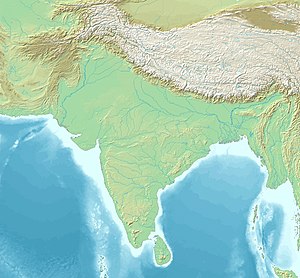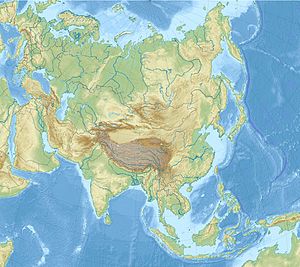Kandahar
Kandahar
| |
|---|---|
Top to bottom and left to right:The Eidgah Jaami Jumat atKandahar University,Friday Mosque of Kandahar,Tomb of Ahmad Shah Durrani,aerial view over theMausoleum of Baba Wali,a Mosque in Kandahar | |
| Coordinates:31°37′12″N65°42′57″E/ 31.62000°N 65.71583°E | |
| Country | |
| Province | Kandahar |
| District | Kandahar |
| Government | |
| • Type | Municipality |
| • Governor | Mohammad Yousaf Wafa |
| Area | |
| • Total | 273.37 km2(105.55 sq mi) |
| Elevation | 1,010 m (3,310 ft) |
| Population (2021) | |
| • Total | 651,484[1] |
| Time zone | UTC+4:30(Afghanistan Standard Time) |
| Postal Code | 38XX |
| Website | kandahar |
Kandahar(English:/ˈkændəhɑːr/;Pashto:کندهار,romanized:Kandahār;Dari:قندهار,romanized:Qandahār) is a city inAfghanistan,located in the south of the country on theArghandab River,at an elevation of 1,010 m (3,310 ft). It is Afghanistan'ssecond largest cityafterKabul,with a population of about 614,118.[2]It is the capital ofKandahar Provinceand the centre of the larger cultural region calledLoy Kandahar.
Kandahar is the founding city and spiritual center of theTaliban.Despite the capital of Afghanistan being Kabul, where the government administration is based, Kandahar is the seat of power in Afghanistan as thesupreme leaderand his spiritual advisers are based there. Kandahar has therefore been called the de facto capital of Afghanistan, though the Taliban maintain Kabul is the capital.[3]
In 1709,Mirwais Hotakmade the region an independent kingdom and turned Kandahar into the capital of theHotak dynasty.In 1747,Ahmad Shah Durrani,founder of theDurrani dynasty,made Kandahar the capital of theAfghan Empire.[4][5]Historically this province is considered as an important political area for Afghanistan revelations. Many empires have long fought over the city due to its strategic location along the trade routes ofsouthern,centralandwestern Asia.
Kandahar is one of the most culturally significant cities of thePashtunscommunity and has been their traditional seat of power for more than 300 years. It is a major trading center for sheep,wool,cotton, silk,felt,food grains,fresh anddried fruit,and tobacco. The region produces fine fruits, especiallypomegranatesand grapes, and the city has plants for canning, drying, and packing fruit, and is a major source ofmarijuanaandhashish.[6]
The region around Kandahar is one of the oldest known human settlements. A major fortified city existed at the site of Kandahar, probably as early asc.1000–750 BC,[7]and it became an important outpost of theAchaemenid (Persian) Empirein the 6th century BC.[8]Alexander the Greathad laid-out the foundation of what is nowOld Kandahar(which is in the southern section of Kandahar city) in the 4th century BC and gave it theAncient Greekname Ἀλεξάνδρεια Ἀραχωσίας (AlexandriaofArachosia).
Name[edit]
Kandahar name has multiple origin theories
The city ofOld Kandaharwas namedAlexandria in Arachosiaafter the invasion ofAlexander the Greatin 330 BC. It is suggested that the name"Kandahar"evolved from"Iskandar"pronounced as"Scandar",in the local dialect version of the nameAlexander.[9]The change of the name from"Scandar"to Candar is mentioned by the 16th-century Portuguese historianJoão de Barrosin his most famous work,Décadas da Ásia.[10][11]
Afolk etymologyoffered is that the word "kand" or "qand" inPersianandPashto(the local languages) is the origin of the word "candy".The name" Candahar "or" Kandahar "in this form probably translates to candy area. This probably has to do with the location beingfertileand historically known for producing fine grapes,pomegranates,apricots,melons and other sweet fruits.[citation needed]
Ernst Herzfeldclaimed Kandahar perpetuated the name of theIndo-ParthiankingGondophares,who re-founded the city under the name Gundopharron.[12]
An alternative etymology derives the name of the city fromGandhara,[13]the name of an ancient Hindu-Buddhist kingdom located between theKunar Riverand Abaseen River, centred on thePeshawar Valley.[14]The name Kandahar (Sanskrit:कंधार) is believed to be linguistically corrupted form of a wordGandhāra(Sanskrit:गंधार), which was used between 2000-1700 BCE.[15]
History[edit]
Historical affiliations
Macedonia330 BC–312 BC
Seleucid Empire312 BC–304 BC
Maurya Empire304 BC–204 BC
Seleucid Empire204 BC–c. 180 BC
Greco-Bactrian Kingdom180 BC-c. 150 BC
Yavana Kingdomc. 150 BC–142 BC
Indo-Scythians142 BC–32 BC
Parthian Empire32 BC–19 CE
Indo-Parthian Kingdom19–36
Kushan Empire36–230
Sasanian Empire230–645
Rashidun Caliphate645–661
Umayyad Caliphate661–750
Abbasid Caliphate750-861
Saffarid dynasty861–977
Ghaznavid Empire977–1175
Ghurid dynasty1175-1207
Khwarazmian Empire1207–1222
Mongol Empire1222-1256
Ilkhanate1256-1347
Kart dynasty1347-1382
Timurid Empire1382-1507
Mughal Empire1507–1649
Safavid Empire1649-1711
Hotak dynasty1711–1738
Afsharid Empire1738–1747
Durrani Empire1747–1818
Principality of Kandahar1818-1839
United Kingdom(Company Raj) 1839-1842
Principality of Kandahar1842-1855
Afghanistan1855–present
Prehistory[edit]
Excavations of prehistoric sites by archaeologists such asLouis Dupreeand others suggest that the region around Kandahar is one of the oldest human settlements known so far.
Early peasant farming villages came into existence in Afghanistan ca. 5000 B.C., or 7000 years ago. Deh Morasi Ghundai, the first prehistoric site to be excavated in Afghanistan, lies 27 km (17 mi) southwest of Kandahar (Dupree, 1951). AnotherBronze Agevillage mound site with multiroomed mud-brick buildings dating from the same period sits nearby at Said Qala (J. Shaffer, 1970). Second millennium B.C. Bronze Agepottery,copper andbronzehorse trappings and stone seals were found in the lowermost levels in the nearby cave called Shamshir Ghar (Dupree, 1950). In theSeistan,southwest of these Kandahar sites, two teams of American archaeologists discovered sites relating to the 2nd millennium B.C. (G. Dales,University Museum, University of Pennsylvania,1969, 1971; W, Trousdale,Smithsonian Institution,1971 – 76). Stylistically the finds from Deh Morasi and Said Qala tie in with those of pre-Indus Valleysites and with those of comparable age on theIranian Plateauand in Central Asia, indicating cultural contacts during this very early age.[16]
— N. Dupree,1971
British excavations in the 1970s discovered that Kandahar existed as a large fortified city during the early 1st millennium BC; while this earliest period at Kandahar has not been precisely dated viaradiocarbon,ceramic comparisons with the latest period at the majorBronze Agecity ofMundigakhave suggested an approximate time-frame of 1000 to 750 BC.[7]This fortified city became an important outpost of theAchaemenid Empirein the 6th to 4th centuries BC, and formed part of the province ofArachosia.[8]
Ancient history[edit]
Foundation of city and Greek invasion
The now "Old Kandahar"was founded in 330 BC byAlexander the Great,near the site of the ancient city ofMundigak(established around 3000 BC era). Mundigak served as the provincial capital of Arachosia and was ruled by theMedesfollowed by the Achaemenids until the arrival of the Macedonians. The main inhabitants of Arachosia were thePakhtas,[17]an ancient Indo-Iranian tribe, who may be among the ancestors of today'sPashtuns.Kandahar was namedAlexandria,a name given to cities that Alexander founded during his conquests.[18]
Kandahar has been a frequent target for conquest because of its strategic location in Asia, controlling the main trade route linking theIndian subcontinentwith theMiddle EastandCentral Asia.[19]The territory became part of theSeleucid Empireafter the death of Alexander. It is mentioned byStrabothat a treaty of friendship was established eventually between the Greeks and theMauryas(Indians).[20][21]The city eventually became part of theGreco-Bactrian Kingdom(250 BC – 125 BC), and continued that way for two hundred years under the laterIndo-Greek Kingdom(180 BC – 10 AD).
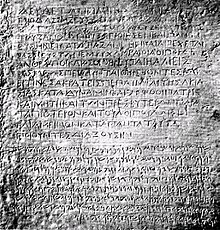
While theDiadochiwere warring amongst themselves, the Mauryas were developing in the northern part of theIndian subcontinent.The founder of the empire,Chandragupta Maurya,confronted a Macedonian invasion force led bySeleucus Iin 305 BC and following a brief conflict, an agreement was reached as Seleucus cededGandharaand Arachosia and areas south ofBagramto the Mauryas. During the 120 years of the Mauryas in southern Afghanistan, Buddhism was introduced and eventually become a major religion alongside Zoroastrianism and local pagan beliefs.
Inscriptions made by Emperor Ashoka, a fragment ofEdict 13in Greek, as well as a full Edict, written in both Greek and Aramaic has been discovered in Kandahar. It is said to be written in excellent Classical Greek, using sophisticated philosophical terms. In this Edict, Ashoka the great uses the wordEusebeia( "Piety") as the Greek translation for the ubiquitous"Dharma"of his other Edicts written inPrakrit.
Medieval history[edit]

Islamic conquest
Till 9th century, Kandahar and other regions ruled by theZunbilswere considered a part of theIndian Subcontinent,though it was an Eastern Iranic realm which followedZurvanism.[22]In the 7th centuryAD,Arab armies conquered the regionwith the new religion of Islam but were unable to succeed in fully converting the population. The leader of the expedition that conquered the city wasAbbad ibn Ziyad,who governed Sijistan between 673 and 681.[23]In AD 870,Yaqub ibn Layth Saffari,a local ruler of theSaffarid dynasty,conquered Kandahar and the rest of the nearby regions in the name of Islam.
Ghanavids
It is believed that theZunbil dynastywere probably the rulers of the Kandahar region from the 7th century until the late 9th century AD.[24]Kandahar was taken bySultan MahmudofGhazniin the 11th century followed by theGhuridsofGhor.
Kandahar appears to have been renamedTeginābādin the 10th-12th centuries, but the origin of the new name is unclear. During this period, nearbyPanjwayserved as the administrative center for the area. However, Kandahar was of much more strategic importance, to the extent thatMinhaj-i-Sirajattributes the downfall of theGhaznavidsto the loss of Kandahar. The city's name was changed back to Kandahar by the 13th century, afterAla ad-Din Husayn JahansuzsackedLashkari Bazar,nearBost.Again, the reason for the name change is not clear.[25]
Mongols
Kandahar was besieged by aMongolarmy in 1221, althoughJalal ad-Din Mingburnudefeated them. In 1251, upon accession to the Mongol throne,Möngke Khangranted Kandahar, along with other lands in Afghanistan, toShams ad-Din Mohammad Kartof theKart dynasty.However, the city is mentioned as being underChagataicontrol in 1260–61; Kandahar didn't come under Kart control until 1281. Later, in 1318, a Chagatai prince raised an army from Kandahar against theIlkhanidgovernor ofSistan.[26]Kandahar was described byIbn Battutain 1333 as a large and prosperous town three nights journey fromGhazni.[27]
Timur the Great,founder of theTimurid Empire,captured Kandahar in 1383. He appointed his grandsonPir Muhammadas governor of Kandahar in 1390.[26]Following his death in 1405, the city was ruled by other Timurid governors. Kandahar was entrusted to theArghunsin the late 15th century, who eventually achieved independence from the Timurids.Guru Nanak,the founder ofSikhism,is believed to have visited the town (c. 1521 AD) during his important journey between Hindustan andMeccain Arabia.
Mughal and Safavid Era
Tamerlane's descendant,Babur,the founder of theMughal Empire,annexed Kandahar in 1508. In 1554, Babur's son,Humayun,handed it over to theSafavidShah Tahmaspin return of 12,000 soldiers he received from the Shah to reconquer India. In 1595,Humayun's sonAkbar the Greatreconquered the city by diplomacy. Akbar died in 1605 and when this news reached the Persian court, Shah Abbas ordered his army to besiege the city which continued until early 1606 and finally failed due to the reinforcements sent by the Mughal EmperorJahangirthat forced the Safavid retreat. In theMughal–Safavid War,Kandahar was once again lost to the Safavids. In 1698, Mughals underSamandar KhanofKalat Statecaptured Kandahar again. Kandahar was regarded as important to the Mughal Empire because it was one of the gateways to India, and Mughal control over Kandahar helped to prevent foreign intrusions.[28]
The memory of the wars fought over Kandahar at this time is preserved in the epic poemQandahār-nāma( "The Campaign Against Qandahār" ), a major work ofSaib Tabriziwhich is a classic of Persian literature.
Modern (1709-2024)[edit]

Mirwais Hotak,chief of theGhiljitribe, revolted in 1709 by killingGurgin Khan,an ethnicGeorgiansubject and governor of the ShiaSafavidPersians. After establishing theHotak dynastyin Kandahar, Mirwais and his army successfully defeated subsequent expeditions byKay Khusrawand Rustam Khán. Mirwais resisted attempts by the Persian government who were seeking to convert the Afghans fromSunnito the Shia sect of Islam. He died of a natural death in November 1715 and was succeeded by his brotherAbdul Aziz,but after being suspected of giving Kandahar's sovereignty back to the Persians he was killed by his nephewMahmud Hotak.[29][30]


In 1722, Mahmud led an army of Afghans to the Safavid capitalIsfahanand proclaimed himself King of Persia. TheHotak dynastywas eventually removed from power by a new Persian ruler,Nader Shah.In 1738, Nader Shah invaded Afghanistan and destroyed the nowOld Kandahar,which was held byHussain Hotakand hisGhiljitribes.[31]In the meantime, Nader Shah freedAhmad Khan(laterAhmad Shah Durrani) and his brother Zulfikar who were held prisoners by the Hotak ruler. Before leaving southern Afghanistan for Delhi in India, Nader Shah laid out the foundation for a new town to be built next to the destroyed ancient city, naming it "Naderabad".His rule ended in June 1747 after being murdered by his Persian guards.[32]
Ahmad Shah Durrani, chief of theDurranitribe, gained control of Kandahar and made it the capital of his newAfghan Empirein October 1747. Initially, Ahmad Shah had trouble finding land on which to build his city. His own tribe had no extensive lands and others who had, such as the Alikozai and Barakzai, refused to give up their lands. Only the Popalzai finally offered him his pick of their lands. The foundations for the city were laid in June, 1761.[33]Once begun, the city was built with grand proportions. It was laid out in the form of a regular rectangle with a circumference of three miles; walls 30 feet thick at the bottom and 15 feet at the top, rose 27 feet high to enclose it. Outside, the walls were ringed by a moat 24 feet wide. Six mammoth gateways pierced these walls: the Eid Gah Gate on the north, the Shikarpur Gate on the south; the Herat and Top Khana Gates on the west; and, the Bar Durrani and Kabul Gates on the east. At its peak, Ahmad Shah's empire included present-day Afghanistan, Pakistan, theKhorasanandKohistanprovinces of Iran, along withPunjabin India. In October 1772, Ahmad Shah retired and died from a natural cause.[34]A new city was laid out by Ahmad Shah and is dominated by his mausoleum, which is adjacent to theMosque of the Cloakin the centre of the city. By 1776, his eldest sonTimur Shahhad transferred Afghanistan's main capital, due to several conflicts with various Pashtun tribes, from Kandahar to Kabul, where theDurranilegacy continued.[16]
From 1818 to 1855, Kandahar was ruled by half-brothers ofDost Mohammad Khanas anindependent principality.In September 1826,Syed Ahmad Shaheed's followers arrived to Kandahar in search of volunteers to help them wagejihadagainst theSikhinvaders to what is now Pakistan. Led byRanjit Singh,theSikhshad captured several of Afghanistan's territories in the east, including what is nowKhyber PakhtunkhwaandKashmir.More than 400 local Kandahar warriors assembled themselves for the jihad. Sayed Din Mohammad Kandharai was appointed as their leader.
British war
British-led Indian forcesfrom neighbouringBritish Indiainvaded the city in 1839, during theFirst Anglo-Afghan War,but withdrew in 1842. In November 1855 Dost Mohammad Khan conquered Kandahar. The British and Indian forces returned in 1878 during theSecond Anglo-Afghan War.They emerged from the city in July 1880 to confront the forces ofAyub Khan,but were defeated at theBattle of Maiwand.They were again forced to withdraw a few years later, despite winning theBattle of Kandahar.
Kandahar remained peaceful for the next 100 years, except during 1929 when loyalists ofHabibullah Kalakani(Bache Saqqaw) placed the fortified city on lock-down and began torturing its population. Nobody was allowed to enter or leave from within the city's tall defensive walls, and as a result of this many people suffered after running out of food supplies. This lasted until October 1929 whenNadir Khanand his Afghan army came to eliminate Kalakani, known as the Tajik bandit from the village ofKalakanin northern Kabul Province.


DuringZahir Shah's rule, the city slowly began expanding by adding modern style streets and housing schemes. In the 1960s, during the rivalry between the United States and the Soviet Union,Kandahar International Airportwas built by theU.S. Army Corps of Engineersnext to the city. The U.S. also completed several other major projects in Kandahar and in other parts of southern Afghanistan. In the meantime, Soviet engineers were busy building major infrastructures in other parts of the country, such asBagram AirfieldandKabul International Airport.
During the 1980s,Soviet–Afghan War,Kandahar city (and the province as a whole) witnessed heavy fighting as it became a centre of resistance as themujahideenforces waged a strongguerrilla warfareagainst theSoviet-backed government,who tightly held on control of the city. Government and Soviet troops surrounded the city and subjected it to heavy air bombardment in which many civilians lost their lives.[35]In January 1982 indiscriminate shelling and bombing by the Soviets killed hundreds.[36][37]300 civilians were killed during Soviet bombings in July 1984.[38]It was under siege again in April 1986.[39]Kandahar International Airport was used by theSoviet Armyduring their ten-year troop placement in the country. The city also became a battle ground for the US and Pakistani-backed forces against the pro-Communist government of Afghanistan. After the Soviet withdrawal and the collapse ofNajibullah's government in 1992, Kandahar fell to local mujahideen commander,Gul Agha Sherzai.However Sherzai lacked authority against other local commanders which led to lawlessness in the city,[40]and fighting in 1993.[41]The city's population was reduced from 200,000 before the war to no more than 25,000 inhabitants, following a months-long campaign of carpet bombing and bulldozing by the Soviets and Afghan communist soldiers in 1987.[42]
In August 1994, theTaliban,underMohammed Omar Mujahid,captured Kandahar from commanderMullah Naqibalmost without a fight[40]and turned the city into their headquarters. The Taliban introduced a strict form ofIslamic law,banning formal education for girls as well as the consumption of TV, films, music with instrumentalaccompaniments,and the playing of sports. In December 1999, a hijackedIndian Airlines Flight 814plane by Pakistani militants loyal toHarkat-ul-Mujahideenlanded at Kandahar International Airport and kept the passengers hostage as part of a demand to release three Pakistani militants from prison in India.
21st century[edit]

In October 2001, as part ofOperation Enduring Freedom,theUnited States Navybeganhitting targetsinside the city byprecision-guidedcruise missilesthat were fired from thePersian Gulf.These targets were the airport and buildings that were occupied by the Taliban, includingArabfamilies who had arrived several years earlier and were residing in the area.[43]About a month later, the Taliban began surrendering in mass numbers to a private militia that had been formed byGul Agha SherzaiandHamid Karzai.[44]Kandahar once again fell into the hands of Sherzai, who had control over the area before the rise of the Taliban. He was transferred in 2003 and replaced byYousef PashtununtilAsadullah Khalidtook the post in 2005.Toryalai Wesawas appointedGovernor of the provinceby President Hamid Karzai in December 2008 afterRahmatullah Raufi's four-month rule.
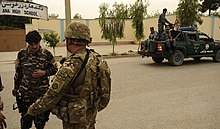
In 2002, Kandahar International Airport started to be used by members of the United States armed forces and NATO'sInternational Security Assistance Force(ISAF). NATO began training the newly formedAfghan National Policeand provided security responsibility of the city. Themilitary of Afghanistan,backed byNATOforces, gradually expanded its authority and presence throughout most of the country. The205th Corpsof theAfghan National Armywas based at Kandahar and provided military assistance to the south of the country. TheCanadian Forcesmaintained their military command headquarters at Kandahar, heading theRegional Command Southof the NATO ledInternational Security Assistance ForceinKandahar Province.The Taliban also had supporters inside the city reporting on events.[45]
NATO forces expanded the Afghan police force for the prevention of a Taliban comeback in Kandahar, the militants'"spiritual birthplace"and a strategic key to ward off theTaliban insurgency,as a part of a larger effort that also aimed to deliver services such as electricity and clean drinking water that the Taliban could not provide – encouraging support for the government in a city that was once the Taliban's headquarters. The most significant battle between NATO troops and the Taliban lasted throughout the summer of 2006, culminating inOperation Medusa.The Taliban failed to defeat the Western troops in open warfare, which marked a turn in their tactics towardsIEDemplacement.[46]In June 2008, it was reported that over 1,000inmates had escapedfromSarposa prison.In Spring 2010, the province and the city of Kandahar became a target of American operations followingOperation Moshtarakin the neighbouringHelmand Province.[47]In March 2010, U.S. and NATO commanders released details of plans for the biggest offensive of the war against the Taliban insurgency.[48]

In May 2010, Kandahar International Airport became subject of a combined rocket and ground attack by insurgents, following similar attacks on Kabul and Bagram in the preceding weeks. Although this attack did not lead to many casualties on the side of NATO forces, it did show that the militants are still capable of launching multiple, coordinated operations in Afghanistan. In June 2010, ashurawas held by Afghan President Hamid Karzai with tribal and religious leaders of the Kandahar region. The meeting highlighted the need for support of NATO-led forces in order to stabilize parts of the province.
By 2011, Kandahar became known as the assassination city of Afghanistan after witnessing many targeted killings. In JulyAhmed Wali Karzai,brother of President Hamid Karzai, was shot by his long time head of security. Soon after theQuetta Shuraof the Taliban claimed responsibility. The next day an Islamic cleric (mulla) of the famousRed Mosquein the Shahr-e Naw area of the city and a number of other people were killed by a Taliban suicide bomber who had hidden explosives inside histurban.On 27 July 2011, the mayor of the city,Ghulam Haider Hamidi,was assassinated by another Taliban militant who had hidden explosives in his turban. Twodeputy mayorshad been killed in 2010,[49]while many tribal elders and Islamic clerics have also been assassinated in the last several years. The overwhelming majority of the victims in the attacks are ordinary Afghan civilians.[50]On 6 June 2012, at least 21 civilians were killed and 50 others injured when two Taliban suicide bombers on motorcycles blew themselves up in a market area near Kandahar International Airport.[51]
On4 May 2020,a policewoman was assassinated in the centre of Kandahar, making her the fifth policewoman to be killed during the previous two months in Kandahar. No group claimed responsibility for the killing of the policewomen by the end of the day of the reported event.[52]
On 12 August 2021, the Talibancaptured Kandahar.After days of brutal clashes withANAsoldiers retreating from the city, the Taliban were finally able to capture the city.[53][54]It became the twelfth provincial capital to be seized by Taliban as part of the wider2021 Taliban offensive.
On 15 October 2021,four suicide bombers killed dozens at a Shia mosque in the city.[55]
Geography[edit]
TheArghandab Riverruns along the west of Kandahar. The city has 15 districts and a total land area of 27,337 hectares.[56]The total number of dwellings in Kandahar is 61,902.[56]
Only 64% of families in Kandahar have access to safe drinking water; 22% of households have access to safe toilet facilities; and 27% of households have access to electricity, with the remainder dependent on public power. Kandahar's transportation infrastructure is well-developed, with 76.8% of the province's roads capable of carrying car traffic in all seasons. However, there are no roads in a minor portion of the province (3.3 percent). In terms of telecommunications, Kandahar City and major roadways are covered by the three major mobile networks AWCC, Roshan, and MTN.[57]
Land use[edit]
Kandahar is the regional hub in southern Afghanistan, close to the border with Pakistan.[56]Non-built up land use accounts for 59% of the total land area.[56]Within the built-up area, vacant plots occupy a slightly higher percentage of land (36%) than residential land (34%).[56]There is a significant commercial cluster along the road to Pakistan in District 5.[56]India, Iran and Pakistan have consulates here for trade, military and political links.
Climate[edit]
Kandahar has ahot semi-arid climate(KöppenBSh),[58]that borders on ahot desert climate(BWh), characterised by little precipitation and high variation between summer and winter temperatures. Summers start in mid-May, last until late September, and are extremely dry. Temperatures peak in July with a 24-hour daily average of around 31.9 °C (89.4 °F). They are followed by dry autumns from early October to late November, with days still averaging in the 20s °C (above 68 °F) into November, although nights are sharply cooler. Winter begins in December and sees most of its precipitation in the form of rain. Temperatures average 5.1 °C (41.2 °F) in January, although lows can drop well below freezing. They end in early March and are followed by a pleasant spring until late April with temperatures generally in the upper 10s °C to lower 30s °C (65–88 °F) range. Sunny weather dominates year-round, especially in summer, when rainfall is extremely rare. The annual mean temperature is 18.6 °C (65.5 °F).
| Climate data for Kandahar (1964–1983) | |||||||||||||
|---|---|---|---|---|---|---|---|---|---|---|---|---|---|
| Month | Jan | Feb | Mar | Apr | May | Jun | Jul | Aug | Sep | Oct | Nov | Dec | Year |
| Record high °C (°F) | 25.0 (77.0) |
26.0 (78.8) |
36.5 (97.7) |
37.1 (98.8) |
43.0 (109.4) |
45.0 (113.0) |
46.5 (115.7) |
44.5 (112.1) |
41.0 (105.8) |
37.5 (99.5) |
31.5 (88.7) |
26.0 (78.8) |
46.5 (115.7) |
| Mean daily maximum °C (°F) | 12.2 (54.0) |
14.8 (58.6) |
21.6 (70.9) |
28.1 (82.6) |
34.1 (93.4) |
39.1 (102.4) |
40.2 (104.4) |
38.2 (100.8) |
34.0 (93.2) |
27.5 (81.5) |
21.0 (69.8) |
15.4 (59.7) |
27.2 (81.0) |
| Daily mean °C (°F) | 5.1 (41.2) |
7.8 (46.0) |
13.9 (57.0) |
20.2 (68.4) |
25.4 (77.7) |
30.0 (86.0) |
31.9 (89.4) |
29.4 (84.9) |
23.5 (74.3) |
17.5 (63.5) |
11.0 (51.8) |
7.3 (45.1) |
18.6 (65.4) |
| Mean daily minimum °C (°F) | 0.0 (32.0) |
2.4 (36.3) |
7.1 (44.8) |
12.3 (54.1) |
15.8 (60.4) |
19.5 (67.1) |
22.5 (72.5) |
20.0 (68.0) |
13.5 (56.3) |
8.5 (47.3) |
3.3 (37.9) |
1.0 (33.8) |
10.5 (50.9) |
| Record low °C (°F) | −12.1 (10.2) |
−10.0 (14.0) |
−4.8 (23.4) |
2.0 (35.6) |
2.4 (36.3) |
8.5 (47.3) |
13.5 (56.3) |
9.0 (48.2) |
5.2 (41.4) |
−2.2 (28.0) |
−9.3 (15.3) |
−11.4 (11.5) |
−12.1 (10.2) |
| Averageprecipitationmm (inches) | 54.0 (2.13) |
42.0 (1.65) |
41.1 (1.62) |
18.7 (0.74) |
2.2 (0.09) |
0 (0) |
2.3 (0.09) |
1.0 (0.04) |
0 (0) |
2.3 (0.09) |
7.0 (0.28) |
20.0 (0.79) |
190.6 (7.52) |
| Average precipitation days | 6 | 6 | 6 | 4 | 1 | 0 | 0 | 0 | 0 | 1 | 2 | 3 | 29 |
| Averagerelative humidity(%) | 58 | 59 | 50 | 41 | 30 | 23 | 25 | 25 | 24 | 29 | 40 | 52 | 38 |
| Mean monthlysunshine hours | 198.4 | 183.6 | 235.6 | 255.0 | 347.2 | 369.0 | 341.0 | 337.9 | 324.0 | 306.9 | 264.0 | 217.0 | 3,379.6 |
| Source: NOAA (1964–1983)[59] | |||||||||||||
Transport[edit]
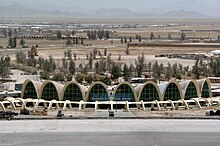
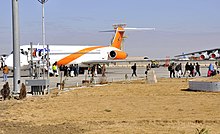
Kandahar International Airportserves as southern Afghanistan's main airport for domestic and international flights. It is also used as a major military base as well as shipping and receiving of supplies for the NATO armies. The entire area in and around the airport is heavily guarded but a section is designated for civilian passengers. Most international flights are to the UAE, Iran, India, Saudi Arabia, and Pakistan.
Pakistan plans to build a railroad track from the Pakistani town ofChamanto Kandahar[60]which will connectAfghan RailwayswithPakistan Railways.Thefeasibility studywas completed in 2006[61]but as of 2012[update]no construction work had begun.[62]
Kandahar is connected toQuettaPakistanviaChamanandKabulby theKabul-Kandahar Highwayand toHeratby theKandahar-Herat Highway.There is a bus station located at the start of the Kabul-Kandahar Highway, where a number of privately owned older-modelMercedes-Benzcoachbuses are available to take passengers to most major cities of the country. Kandahar is also connected by road toQuettain neighbouring Pakistan. Due to the ongoing war, the route to Kabul has become increasingly dangerous as insurgent attacks on convoys and destruction of bridges make it an unreliable link between the two cities.[63][64]
Commuters in the city of Kandahar use the public bus system (Milli Bus), and taxicabs andrickshawsare common. Private vehicle use is increasing, partially due to road and highway improvements. Large dealerships are importing cars fromDubai,UAE.[65]
Demographics and population[edit]
Kandahar has a population of approximately 1,057,500 people in 2008. In the province, there are around 14,445 households, with an average of seven individuals per home. Around 68 percent of Kandahar's population resides in rural districts, with males accounting for 51 percent of the population. Pashtuns are the province's largest ethnic group. Major Pashtun tribes such as theTareenorDurraniincluding Barakzai, Popalzai, Alkozai, Noorzai, Ishaqzai, Achakzai, Maku, and Qizilbash Shia's andKhiljiare included. More than 98 percent of the population speaks Pashtu. 88 center for learning army lessons. Only a small percentage of the population speaksBalochi languageandDari.Kochi people(Pashtun Nomads) also live in Kandahar province, and their numbers fluctuate depending on the season, with estimates stating approximately 79,000 in the winter and 39,000 in the summer.[57]
Education[edit]

Before the 1978 coup in Kabul, majority of the city's population were enrolled in schools.[citation needed]Nearly all of the elite class of the city fled to neighboring Pakistan during the early 1980s, and from there they began immigrating to North America, Europe,Australiaand other parts of the world.
The two oldest known schools are Ahmad Shah Baba High School and Zarghona Ana High School. There are a number of new schools that opened in the last decade, with more being built in the future as the city's population grows with the large returning Afghans from neighboring countries.Afghan Turk High Schoolsis one of the top private schools in the city.
The main university is theKandahar University.A number of private higher education institutions have also opened in the last decade such as Benawa Institute of Higher Education, Mirwais Neeka Institute of Higher Education, Malalay Institute of Higher Education and Saba Institute of Higher Education.[66][67][68][69]
The adult literacy rate ratio was 16.8% in 2012.[2]Archived17 March 2023 at theWayback Machine
Communications[edit]
Telecommunication services in the city are provided byAfghan Wireless,Roshan,Etisalat,MTN GroupandAfghan Telecom.In November 2006, theAfghan Ministry of Communicationssigned a $64.5 million agreement withZTEfor the establishment of a countrywide fibre optical cable network. This was intended to improve telephone, internet, television and radio broadcast services not just in Kandahar but throughout the country.
Places of interest[edit]
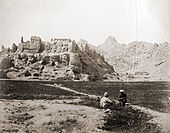
The tomb ofAhmad Shah Durraniis located in the city centre, which also houses Durrani's brass helmet and other personal items. In front of Durrani's mausoleum is theShrine of the Cloak,containing one of the most valued relics in the Islamic world, which was given by the Emir ofBokhara(Murad Beg) to Ahmad Shah Durrani. The Sacred Cloak is kept locked away, taken out only at times of great crisis.Mullah Omartook it out in November 1996 and displayed it to a crowd ofulemaof religious scholars to have himself declaredAmir al-Mu'minin(Commander of the Faithful). Prior to that it was taken out when the city was struck by a cholera epidemic in the 1930s.[70]
The village ofSher Surkhis located southeast of the city, in the suburbs of the old city ofNadirabad.Kandahar Museum is located at the western end of the third block of buildings lining the main road east ofEidgah Durwaza(gate). It has many paintings by the now famous Ghiyassuddin, painted while he was a young teacher in Kandahar. He is acknowledged among Afghanistan's leading artists.
Just to the north of the city, off its northeast corner at the end ofburia(matting) bazaar, there is a shrine dedicated to a saint who lived in Kandahar more than 300 years ago. The grave ofHazratji Baba,7.0 m (23 ft) long to signify his greatness, but otherwise covered solely by rock chips, is undecorated save for tall pennants at its head. A monument to Islamic martyrs stands in the centre of Kandahar's main square, calledDa Shahidanu Chawk,which was built in the 1940s.
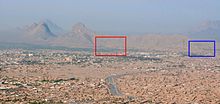
TheChilzinais a rock-cut chamber above the plain at the end of the rugged chain of mountains forming the western defence of Kandahar'sOld City.This is here thatAshoka'sKandahar Bilingual Rock Inscriptionwas found. Forty steps, about, lead to the chamber, which is guarded by two chained lions, defaced, and inscribed with an account ofMughalconquest. The rugged cliffs from which theChilzinawas hewn form the natural western bastion of theOld Cityof Kandahar, which was destroyed in 1738 byNadir Shah Afsharof Persia.
A short distance fromChilzina,going west on the main highway, a bright blue dome appears on the right. This is the mausoleum ofMirwais Hotak,the Ghiljai chieftain who declared Kandahar's independence from the Persians in 1709. The shrine ofBaba Wali Kandhari[71](Baba Sahib), its terraces shaded by pomegranate groves beside theArghandab River,is also very popular for picnics and afternoon outings.[16]He was a Muslimpirwho had a strange encounter withGuru NanakatHasan Abdalin what is nowAttock Districtof Pakistan. The shrine of Baba Wali is important to Muslims andSikhs.Close to Baba Wali's shrine is a military base established by theUnited States armed forcesin about 2007.
Development and modernization[edit]

Decades of war left Kandahar and the rest of the country destroyed and depopulated, but in recent years billions of dollars began pouring in for construction purposes and millions of expats have returned to Afghanistan. New residential areas have been established around the city, and a number of modern-style buildings have been constructed.
Some residents of the city have access to clean drinking water and electricity, and the government is working to extend these services to every home.[73]The city relies on electricity from theKajakihydroelectricityplant in neighbouringHelmand,which is being upgraded or expanded. About 30 km (20 mi) north of the city is theDahla Dam,the second largestdam in Afghanistan.
TheAino Minais a new housing project for up to two million people on the northern edge of the city.[74]Originally called theKandahar Valleyand started byMahmud Karzai,[72]it was announced that the project would build up to 20,000 single-family homes and associated infrastructure such as roads, water and sewer systems, andcommunity buildings,including schools.[75]
It recently won 2 awards, theResidential ProjectandSustainable Projectof the Year at the Middle East Architect Awards.[76]Many of the high-ranking government employees and civil servants as well as wealthy businessmen live in this area, which is a more secured community in Kandahar. Work on the next $100 million scheme was initiated in 2011.
Also, construction of Hamidi Township in the Morchi Kotal area of the city began in August 2011. It is named afterGhulam Haider Hamidi,the mayor of Kandahar who was assassinated by militants in late July 2011.[77]Situated along the Kandahar-Uruzgan Highway in the northeast of the city, the new township will have 2,000 residential and commercial plots. Including new roads, schools, commercial markets, clinics, canals and other facilities.[78]
About 10 km (6 mi) east of Kandahar, a hugeindustrial parkis under construction with modern facilities. The park will have professional management for the daily maintenance of public roads, internal streets, common areas, parking areas, 24 hours perimeter security, access control for vehicles and persons.[79]

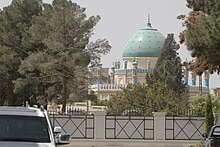





Airports[edit]
Neighborhoods[edit]
- Aino Meyna(under development since 2003)
- Hamidi Meyna (under development since 2011)
- Share Naw(meaningNew City)
- Dand
- Karz
- Mirwais Meyna
- Daman
- Sarpuza
- Malajat
- Old Kandahar(Zorr Shar)
- Arghandab Valley
Cultural sites and parks[edit]
- Kandahar Park[3]Archived19 November 2015 at theWayback Machine
- Baba Saab
- Kokaran Park
- Baghi Pul Park[4]
- Chilzina View (Moghul EmperorBabur'sinscriptionsite)
- Kandahar Museum
Mosques and shrines[edit]
- Friday Mosque of Kandahar
- Mosque of the Hair of the Prophet
- Omar Al-Farooq Mosque
- Shrine of the Cloak
- Mosque atKandahar University(Eidgah Jaami Jumat)
Mausoleums[edit]
- Mausoleum ofAhmad Shah Durrani
- Mausoleum ofMirwais Hotak
- Mausoleum of Baba Wali
Shopping[edit]
- Al-Jadeed indoor shopping center[5]Archived2 January 2017 at theWayback Machine
- HeratBazaar
- Kabul Bazaar
- Shah Bazaar
- Shkar Pur Bazaar
- Piaroz Super store
- Kandahr Super Store
- Samimi Super Store
Hospitals[edit]
Banks[edit]
Sports[edit]
- Professional sports teams from Kandahar
| Club | League | Sport | Venue | Established |
|---|---|---|---|---|
| Kandahar Knights | Afghanistan Premier League | Cricket | Sharjah Cricket Stadium | 2018 |
| Boost Defenders | Shpageeza Cricket League | Cricket | Kandahar International Cricket Stadium | 2013 |
| De Maiwand Atalan F.C. | Afghan Premier League | Football | Kandahar Stadium | 2012 |
Stadium[edit]
- Kandahar International Cricket Stadium(under construction)[80]
- Kandahar Stadiumused for football[81]
- Ahmad Shahi Stadium, with 20,000 capacity, used for football
Demography and culture[edit]

The population of Kandahar numbers approximately 651,484 as of 2021[update].[1]ThePashtunsmake up the overwhelming majority population of the city and province but exact figures are not available. In a 2003 estimate by theNational Geographic,Pashtuns were put at ca. 70%,Tajiks20%,Baloch2%, andUzbeks2%.[82]
Pashtois the main language in the city and the region.Persianis also understood by a few number of the city dwellers, especially those serving in the government. Both are the officiallanguages of Afghanistan.A 2006 compendium of provincial data prepared by the AfghanMinistry of Rural Rehabilitation and DevelopmentandUnited Nations Assistance Mission in Afghanistan(UNAMA) states:
"The major ethnic group living in Khandahar province is Pashtoons. This includes major tribes such asTareenorDurranisub tribes includingBarakzai,Popalzai,Alkozai,Achakzai,Ishaqzai,NoorzaiandAlezai.Pashtuis spoken by more than 98% of population and in more than 98% of villages.Dariis spoken in six villages by 4000 people andBalochiis spoken by 8000 people in two villages. 19000 people in nine villages speak some other unspecified language. "[83]
In another report, by BBC news Farsi, there are roughly 50,000-100,000 Tajik or Persian speakers in the city of Kandahar.[84]The "Council for Tajiks of the south" head office is also based in Kandahar city.[85]
ThePashtun culture,history,traditions,clothingandPashtunwaliis dominant in this region.
Notable people[edit]
- Kandahari Begum,wife of Mughal emperor Shah Jahan
- Nur Jahan– Empress of theMughal Empire,chief wife of Mughal emperor Jahangir
- Mirwais Hotak– founder of theHotak dynasty
- Abdul Aziz Hotak– ruler of the Hotak dynasty
- Mahmud Hotak– ruler of the Hotak dynasty and Shah of Persia
- Ashraf Hotak– Shah of Persia
- Hussain Hotak– ruler of the Hotak dynasty
- Ahmad Shah Durrani– founding father of Afghanistan, buried in the city
- Dost Mohammad Khan– Emir of Afghanistan and son of Payandah Khan
- Sher Ali Khan– Emir of Afghanistan and son of Dost Mohammad Khan
- Abdur Rahman Khan– Emir of Afghanistan and son of Dost Mohammad Khan
- Ghulam Muhammad Tarzi– leader ofTarzifamily who played an important part in Afghan history during the late 19th century onward
- Abdul Rehman Khan, father ofBollywoodactorKader Khan
- Mohammad Ibraheem Khwakhuzhi
- Maryam Duranian Afghan activist and women's advocate
- Ubaidullah Jan– Pashto music king of southern Afghanistan
- Naghma– Afghan singer
- Nashenas–Afghan musician
- Abdul Hai Habibi– scholar, former professor atKabul Universityand author of many books
- TheKarzais– the family of Afghan PresidentHamid Karzai
- Gul Agha Sherzai– served as thegovernor of Kandahar Provincefollowed by asgovernors of Nangarhar Province
- Said Tayeb Jawad– formerAfghanistan Ambassadorto the United States
- Yousef Pashtun– Afghan politician
- Nasrat Haqparast- UFC Lightweight Fighter
- Khan Mohammad Mujahid– Alokozai tribe leader
- Malalai of Maiwand– National folk hero of Afghanistan
- Hibatullah Akhundzada– Supreme leader of Afghanistan as of 2021
- Akhtar Mansour– Second supreme leader of theTaliban
See also[edit]
Footnotes[edit]
- ^ab"Estimated Population of Afghanistan 2021-22"(PDF).National Statistic and Information Authority (NSIA). April 2021. Archived fromthe original(PDF)on 24 June 2021.Retrieved21 June2021.
- ^"The State of Afghan Cities report2015".Archived fromthe originalon 31 October 2015.
- ^Ikramullah Ikram; Abubakar Siddique (18 April 2023)."Southern Afghan City Becomes De Facto Capital As Taliban Chief Tightens Grip On Power".Radio Free Europe/Radio Liberty.Archivedfrom the original on 11 May 2023.Retrieved11 May2023.
- ^"Kandahar".Columbia Encyclopedia.Archivedfrom the original on 20 February 2021.Retrieved9 January2011.
- ^"The City of Kandahar".Columbia Encyclopedia.Archived fromthe originalon 15 May 2011.Retrieved9 January2011.
- ^"Afghanistan's Misguided Economy | Boston Review".8 February 2014.Archivedfrom the original on 8 February 2014.Retrieved9 January2023.
- ^abF.R. Allchin (ed.),The Archaeology of Early Historic South Asia: The Emergence of Cities and StatesArchived1 May 2021 at theWayback Machine(Cambridge University Press, 1995), pp.127-130
- ^abGérard Fussman,"Kandahar II. Pre-Islamic Monuments and Remains"Archived12 November 2017 at theWayback Machine,inEncyclopædia Iranica,online edition, 2012
- ^John E. Hill,Through the Jade Gate to Rome: A Study of the Silk Routes during the Later Han dynasty, 1st to 2nd centuries AD.BookSurge, Charleston, South Carolina, 2009.ISBN978-1-4392-2134-1,pp. 517–518. This derivation, as that from Gondophares, was characterised as "philologiquement impossible" by P. Bernard, "Un probleme de toponymie antique dans l'Asie Centrale: les noms anciens de Qandahar",Studia Iranica,tome 3, 1974 andAfghanistan Quarterly,vol.33, no.1, June 1980/Spring 1359, pp.49–62, p59, n.10.
- ^Barros, João de (1552).Da Asia De Joāo De Barros: Dos Feitos, Que Os Portuguezes Fizeram No Descubrimento, E Conquista Dos Mares, E Terras Do Oriente. Decada Quarta. Parte Segunda(in Portuguese). Na Regia Officina Typografica.Archivedfrom the original on 1 May 2021.Retrieved2 October2020.
Those who go from Persia, from the kingdom of Horaçam (Khorasan), from Bohára, and all the Western Regions, travel to the city which the natives corruptly call Candar, instead of Scandar, the name by which the Persians call Alexander.:ruptamente Candar, havendo de dizer Scandar, nome per que os Perfas chamam Alexandre, por elle (como efcreve Arriano ") edificar efia Cidade, e do feu nome fe chamou Alexandria fituada...
- ^Those who go from Persia, from the kingdom of Horaçam (Khorasan), from Bohára, and all the Western Regions, travel to the city which the natives corruptly call Candar, instead of Scandar, the name by which the Persians call Alexander
- ^Ernst Herzfeld,Archaeological History of Iran,London, Oxford University Press for the British Academy, 1935, p.63; Ernst Herzfeld,The Persian Empire: Studies in Geography and Ethnography of the Ancient Near East,Wiesbaden, Steiner, 1968, p.335.
- ^Hobson Jobson DictionaryArchived7 July 2012 atarchive.today;The Practical Sanskrit-English Dictionary,Vaman Shivram Apte, Motilal Banarsidass, Delhi, India, 1975,ISBN81-208-0567-4;P. Bernard, "Une probleme de toponymie antique dans l'Asie centrale: les noms anciens de Qandahar",Studia Iranica,tome 3 (fasc. 2) 1974, 171–185.
- ^Tarn, William Woodthorpe (24 June 2010).The Greeks in Bactria and India.Cambridge University Press.ISBN9781108009416.Archivedfrom the original on 25 June 2021.Retrieved25 June2021.
- ^Singh, Upinder.A History of Ancient and Early Medieval India: From the Stone Age to the 12th Century.Pearson Education India.p. 264.
- ^abcDupree, Nancy Hatch (1970).An Historical Guide to Afghanistan.Vol. First Edition. Kabul: Afghan Air Authority, Afghan Tourist Organization. p. 492.Archivedfrom the original on 7 May 2021.Retrieved17 June2012.
- ^Map of theMedian Empirefrom the University of Texas in Austin, showingPactyansin what is now Kandahar, Afghanistan...LinkArchived4 October 2003 at theWayback Machine
- ^Lendering, Jona."Alexandria in Arachosia".LIVIUS – Articles on Ancient History. Archived fromthe originalon 15 June 2010.Retrieved9 January2011.
- ^Mentioned in Bopearachchi, "Monnaies Greco-Bactriennes et Indo-Grecques", p52. Original text in paragraph 19 ofParthian stationsArchived31 May 2020 at theWayback Machine
- ^Nancy Hatch Dupree/ Aḥmad ʻAlī Kuhzād (1972)."An Historical Guide to Kabul – The Story of Kabul".American International School of Kabul. Archived fromthe originalon 30 August 2010.Retrieved18 September2010.
- ^Lendering, Jona."Maurya dynasty".LIVIUS – Articles on Ancient History. Archived fromthe originalon 26 February 2012.Retrieved9 January2011.
- ^Wink, André (2002).Al-Hind, the Making of the Indo-Islamic World: Early Medieval India and the Expansion of Islam 7Th-11th Centuries.BRILL. p. 114.ISBN978-0-391-04173-8.Archivedfrom the original on 5 April 2023.Retrieved5 April2023.
- ^Zetterstéen, K. V. (1960)."ʿAbbād b. Ziyād".InGibb, H. A. R.;Kramers, J. H.;Lévi-Provençal, E.;Schacht, J.;Lewis, B.&Pellat, Ch.(eds.).The Encyclopaedia of Islam, Second Edition.Volume I: A–B.Leiden: E. J. Brill. p. 5.OCLC495469456.
- ^Excavations at Kandahar 1974 & 1975 (Society for South Asian Studies Monograph) by Anthony McNicoll.
The Zunbils ruled in the Kandahar area for nearly 250 years until the late 9th century AD.
- ^Inaba, Minoru."KANDAHAR iii. Early Islamic Period".Encyclopaedia Iranica.Archivedfrom the original on 21 February 2020.Retrieved9 March2020.
- ^abMatthee, Rudi; Mashita, Hiroyuki."KANDAHAR iv. From The Mongol Invasion Through The Safavid Era".Encyclopaedia Iranica.Archivedfrom the original on 28 October 2014.Retrieved9 March2020.
- ^Ibn Battuta (2004).Travels in Asia and Africa, 1325–1354(reprint, illustrated ed.). Routledge. p. 179.ISBN0-415-34473-5.Archivedfrom the original on 2 July 2021.Retrieved4 August2012.
- ^Sen, Sailendra (2013).A Textbook of Medieval Indian History.Primus Books. pp. 151, 162, 169–170.ISBN978-93-80607-34-4.
- ^"AN OUTLINE OF THE HISTORY OF PERSIA DURING THE LAST TWO CENTURIES (A.D. 1722–1922)".Edward Granville Browne.London: Packard Humanities Institute. p. 29. Archived fromthe originalon 11 October 2017.Retrieved24 September2010.
- ^Malleson, George Bruce (1878).History of Afghanistan, from the Earliest Period to the Outbreak of the War of 1878.London: Elibron. p. 227.ISBN1-4021-7278-8.Archivedfrom the original on 16 April 2017.Retrieved27 September2010.
- ^"Last Afghan empire".Louis Dupree, Nancy H. Dupree and others.Encyclopædia Britannica Online.Archivedfrom the original on 30 November 2010.Retrieved24 September2010.
- ^The Afghans(2002) byWillem Vogelsang.Page 228.
- ^Dupree, Nancy (1977).An Historical Guide to Afghanistan.Jagra, Ltd. p. 281.
- ^"Aḥmad Shah Durrānī".BritannicaOnline Version.Archivedfrom the original on 4 April 2014.Retrieved9 January2011.
- ^"The Limits of Soviet Airpower: The Failure of Military Coercion in Afghanistan, 1979–89".Edward B. Westermann.University of New Brunswick.Archivedfrom the original on 5 June 2011.Retrieved9 January2011.
- ^"The Heritage Foundation".Archived fromthe originalon 12 January 2018.Retrieved11 January2018.
- ^Middleton, Drew (8 March 1982)."Soviet Reprisals on Afghans Called Fierce".The New York Times.Archivedfrom the original on 12 January 2018.Retrieved29 January2018.
- ^"Soviet forces bombed the city of Kandahar in southern".Archivedfrom the original on 12 January 2018.Retrieved11 January2018.
- ^"Soviet-Afghan Offensive Destroys Rebel Stronghold".Associated Press.Archivedfrom the original on 7 June 2020.Retrieved7 June2020.
- ^ab"Kandahar on brink of chaos as warlords ready for battle".TheGuardian.9 December 2001.Archivedfrom the original on 4 January 2019.Retrieved4 January2019.
- ^Zaeef, Mohammad (7 August 2012).My life with the Taliban.Hachette India.ISBN9789350094136.Archivedfrom the original on 1 May 2021.Retrieved7 June2020.
- ^Kaplan 2008,p. 188.
- ^BBC News,Kandahar's cemetery of 'miracles'Archived20 January 2008 at theWayback Machine
- ^"Home Free".Time.Archived fromthe originalon 24 July 2009.Retrieved9 January2011.
Hamid Karzaidreamed for years of his eventual homecoming. But for both him and his newly reborn nation, the journey has only begun
- ^BBC News,Kandahar dreamers test Taliban edictsArchived18 August 2009 at theWayback Machine
- ^"Removed: news agency feed article".the Guardian.9 December 2015.Archivedfrom the original on 20 September 2022.Retrieved6 May2016.
- ^"Kandahar, a Battlefield Even Before U.S. Offensive".The New York Times.27 March 2010.Archivedfrom the original on 3 January 2022.Retrieved6 May2016.
- ^"Q+A – NATO sees Kandahar battle as Afghan turning point".Reuters Editorial.Reuters India. 31 March 2010.Archivedfrom the original on 20 September 2022.Retrieved6 May2016.
- ^"Kandahar mayor killed in suicide attack; Taliban claim responsibility".Archivedfrom the original on 4 March 2016.Retrieved6 May2016.
- ^Challenges remain despite reduced rebel attacks: ISAFArchived12 June 2013 at theWayback Machine.Pajhwok Afghan News. 10 October 2011.
- ^Siddiqullah, ed. (7 June 2012)."21 killed, 50 injured in twin suicide blasts (Video)".Pajhwok Afghan News. Archived fromthe originalon 12 June 2013.Retrieved8 June2012.
- ^"Taliban Claim Attack on Afghan Army Base".4 May 2020.Archivedfrom the original on 16 August 2021.Retrieved28 May2020– via voanews /.
- ^Akhgar, Tameem (12 August 2021)."Taliban take Kandahar, Herat in major Afghanistan offensive".Apnews.Archivedfrom the original on 12 August 2021.Retrieved12 August2021.
- ^Goldbaum, Christina (12 August 2021)."Afghanistan Collapse Accelerates as 2 Vital Cities Near Fall to Taliban".The New York Times.Archived fromthe originalon 28 December 2021.Retrieved12 August2021.
- ^"Afghanistan: At least 35 killed in suicide bombing during prayers at Kandahar mosque".Sky News.Archivedfrom the original on 16 October 2021.Retrieved15 October2021.
- ^abcdef"The State of Afghan Cities report 2015".Archived fromthe originalon 31 October 2015.Retrieved22 October2015.
- ^ab"Afghanistan Provincial Reconstruction Handbook"(PDF).February 2011. p. 88.Archived(PDF)from the original on 26 June 2023.Retrieved21 September2023.
- ^[1]Archived14 February 2010 at theWayback Machine(in Russian)
- ^"Kandahar Climate Normals 1964–1983".National Oceanic and Atmospheric Administration.Archivedfrom the original on 20 September 2022.Retrieved26 December2012.
- ^Sial, Amer (18 August 2016)."Pak Railways poised to get massive funding from CPEC and CAREC".Pakistan Today.Archivedfrom the original on 24 March 2017.Retrieved23 March2017.
- ^Kakar, Javed Hamim (7 July 2010)."Pakistan, Afghanistan ink MoU on rail links".Pajhwok Afghan News.Archived fromthe originalon 13 March 2012.Retrieved23 October2008.
- ^Kandahar-Quetta bus service soon By Bashir Ahmad Naadim 20 Jul 2012 – 17:17,http:// pajhwok /en/2012/07/20/kandahar-quetta-bus-service-soonArchived30 May 2014 at theWayback Machine
- ^Cogan, James (16 August 2008)."Hundreds dead in fighting along Afghanistan-Pakistan border".World Socialist Web Site.Archivedfrom the original on 2 September 2008.Retrieved25 August2008.
- ^Salih, Salih Muhammad; Siddique, Abubakar (23 October 2008)."Death stalks the highway to hell".Asia Times Online.Archived from the original on 27 August 2011.Retrieved23 October2008.
{{cite news}}:CS1 maint: unfit URL (link) - ^Wheeler, Tony (6 June 2006)."Afghanistan Practicalities".Lonely Planet.Archivedfrom the original on 7 January 2011.Retrieved9 January2011.
- ^"Benawa Institute of Higher Education | Tuition | Admission - Counselor Corporation".8 July 2020.Archivedfrom the original on 28 July 2021.Retrieved28 July2021.
- ^"Mirwais Neeka Institute of Higher Education - Counselor Corporation".19 September 2020.Archivedfrom the original on 28 July 2021.Retrieved28 July2021.
- ^"Saba Institute of Higher Education | Fee & Academics - Counselor Corporation".27 September 2020.Archivedfrom the original on 28 July 2021.Retrieved28 July2021.
- ^"Malalay University | Tuition and Fees | Academics - Counselor Corporation".19 September 2020.Archivedfrom the original on 28 July 2021.Retrieved28 July2021.
- ^Lamb, Christina (2002).The Sewing Circles of Herat: A Personal Voyage Through Afghanistan.Harper Collins. First Perennial edition (2004), p. 38 and n.ISBN0-06-050527-3.
- ^ab"Punja Sahib: The Miracle at Hassan Abdal".Wonders of Pakistan.13 April 2009.Archivedfrom the original on 13 March 2016.Retrieved6 May2016.
- ^abCusack, Jake (19 July 2011)."Spending Time With the Karzais in (Parts of) Kandahar".The New York Times.Archivedfrom the original on 8 August 2012.Retrieved20 October2012.
- ^South Asian News Agency,30 Power Generators to Be Installed in Kandahar[permanent dead link]
- ^"Aino Mina Development".Archived fromthe originalon 4 March 2016.Retrieved6 May2016.
- ^U.S. Department of State,U.S. Government Agency Grants $3 Million to Build Afghan HomesArchived4 October 2006 at theWayback Machine
- ^"Case study: Aino Mina".Design Middle East.Archived fromthe originalon 6 January 2014.Retrieved6 May2016.
- ^Kandahar mayor killed by suicide bomber with explosives in turban[permanent dead link]
- ^Naadem, Bashir Ahmed (16 August 2011)."Construction of Hameedi township starts in Kandahar".Archived fromthe originalon 8 September 2012.Retrieved16 August2011.
- ^Afghanistan Investment Support Agency,Afghanistan Industrial Parks Development AuthorityArchived21 July 2006 at theWayback Machine
- ^"20 acres of land donated for cricket stadium in Kandahar | Pajhwok Afghan News".29 May 2014.Archivedfrom the original on 29 May 2014.Retrieved8 May2021.
- ^Iqbal Ahmad Esmati (13 February 2005),Football Ground,archivedfrom the original on 10 August 2016,retrieved8 May2021
- ^"2003 National Geographic Population Map"(PDF).Thomas Gouttierre, Center For Afghanistan Studies,University of Nebraskaat Omaha; Matthew S. Baker, Stratfor.National Geographic Society.2003. Archived fromthe original(PDF)on 12 September 2017.Retrieved11 April2011.
- ^"B. Demography and Population"(PDF).United Nations Assistance Mission in Afghanistanand Afghanistan Statistical Yearbook 2006, Central Statistics Office.Afghanistan'sMinistry of Rural Rehabilitation and Development.Archived fromthe original(PDF)on 21 March 2012.
- ^هنریار, ارشاد (26 May 2019)."فارسی زبانهای قندهار؛ پیشتاز زرگری و رایگیری".BBC News فارسی(in Persian).Archivedfrom the original on 7 August 2020.Retrieved26 July2020.
- ^"شورای همبستگی تاجیکان قندهار آغاز به فعالیت کرد".tajikmedia.Archivedfrom the original on 26 July 2020.Retrieved26 July2020.
References[edit]
- Dupree, Nancy Hatch (1977) [1st Edition: 1970].An Historical Guide to Afghanistan(2nd Edition, Revised and Enlarged ed.). Afghan Tourist Organization.
- Hill, John E. 2004.The Peoples of the West from the WeilueArchived23 December 2017 at theWayback MachineNgụy lượcby Yu HuanCá hoạn:A Third Century Chinese Account Composed between 239 and 265 CE.Draft annotated English translation.
- Hill, John E. (2009)Through the Jade Gate to Rome: A Study of the Silk Routes during the Later Han dynasty, 1st to 2nd centuries CE.BookSurge, Charleston, South Carolina.ISBN978-1-4392-2134-1.
- Frye, Richard N. (1963).The Heritage of Persia.World Publishing company, Cleveland, Ohio. Mentor Book edition, 1966.
- Kaplan, Robert D.(2008).Soldiers of God: With Islamic Warriors in Afghanistan and Pakistan.Knopf Doubleday Publishing Group.ISBN978-0-307-54698-2.OCLC48367823.
- Toynbee, Arnold J. (1961).Between Oxus and Jumna.London. Oxford University Press.
- Willem Vogelsang(1985). "Early historical Arachosia in South-east Afghanistan; Meeting-place between East and West."Iranica antiqua,20 (1985), pp. 55–99.
- Wood, Michael (1997).In the Footsteps of Alexander the Great: A Journey from Greece to Asia.University of California Press.ISBN0-520-23192-9
Further reading[edit]
- Published in the 19th century
- Edward Balfour(1885),"Kandahar",Cyclopaedia of India(3rd ed.), London: B. Quaritch
- Boulger, Demetrius Charles.Ought We to Hold Candahar?Archived26 December 2013 at theWayback Machine.London: William H. Allen and Company (1879).
- Published in the 20th century
- Holdich, Thomas Hungerford(1911)..Encyclopædia Britannica.Vol. 15 (11th ed.). pp. 648–649.
- Published in the 21st century
- C. Edmund Bosworth, ed. (2007). "Kandahar".Historic Cities of the Islamic World.Leiden:Koninklijke Brill.









